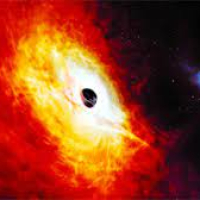Object of Highest Luminosity Discovered:
Object of Highest Luminosity Discovered:
Recently, astronomers utilizing the European Southern Observatory’s (ESO) Very Large Telescope (VLT) have pinpointed a radiant quasar, not only distinguished as the brightest of its category but also hailed as the most luminous entity ever documented.
Quasars, the radiant cores of
remote galaxies, draw their power from supermassive black holes. These black
holes amass matter from their surroundings with such vigor that they emit
copious amounts of light, rendering quasars some of the most brilliant objects
visible in our sky, with some even discernible from Earth's vantage point.
Discovery and Attributes:
The black hole within this groundbreaking quasar is expanding in mass at a rate equivalent to one solar mass per day, setting a new record as the fastest-growing black hole on record. Typically, the most luminous quasars signify the most rapidly expanding supermassive black holes. This particular black hole, boasting a mass equivalent to 17 billion Suns, is declared to be the most luminous entity in the observable Universe, according to astronomers from Australian National University (ANU).
Named J0529-4351, the quasar is situated so far from Earth that its light has traveled over 12 billion years to reach us. The matter being drawn toward the black hole, in the form of a disc, emits such prodigious energy that J0529-4351 shines over 500 trillion times brighter than the Sun.
Seven Light Years:
This extraordinary luminosity emanates from a scorching accretion disc spanning seven light-years in diameter, likely the largest accretion disc known in the Universe. To put it into perspective, 'seven light-years' is roughly 15,000 times the distance from the Sun to the orbit of Neptune.
Despite appearing in images from the ESO Schmidt Southern Sky Survey as far back as 1980, this object wasn't recognized as a quasar until decades later.
Machine Learning in Analysis:
Given the immense size of resulting datasets, researchers frequently employ machine-learning models to sift through them and distinguish quasars from other celestial phenomena. However, these models are trained on existing data, which can constrain potential candidates to objects resembling those already identified. If a newly discovered quasar shines more brightly than any previously observed, the program might misclassify it as a nearby star rather than a distant quasar.
An automated analysis of data from the European Space Agency’s Gaia satellite initially misclassified J0529-4351 as a star due to its extraordinary brightness, highlighting the complexities of celestial classification.
Know More:
Read
daily current affairs in English : Click Here
Read
daily current affairs in Tamil : Click Here
Check
the latest jobs update details : Click Here
Our Achievements:
https://www.youtube.com/watch?v=MLRj6js0X5U
https://www.youtube.com/watch?v=ung7VREhwYI
Download our Mobile Application: Android Mobile | IOS Mobiles
Our Website's:
https://www.bestlearningcentre.in/
Office Location:
https://goo.gl/maps/9JCNNv3HAkC4b92X7
For any clarification, you may contact us at any time.
Educational Counsellor: 7418968881
Customer Support: 7418978881
Enrol Now for Fresh Batch in UPSC | TNPSC | BANK | SSC | RRB |
POLICE | TNTET | CTET | NDA| CDS | AFCAT | DEFENCE | TANCET | CAT | MAT | ZAT
EXAMS.
Call Admission Desk: 7418968881
Book Free Demo Class Now !
Batches available in ONLINE & OFFLINE
